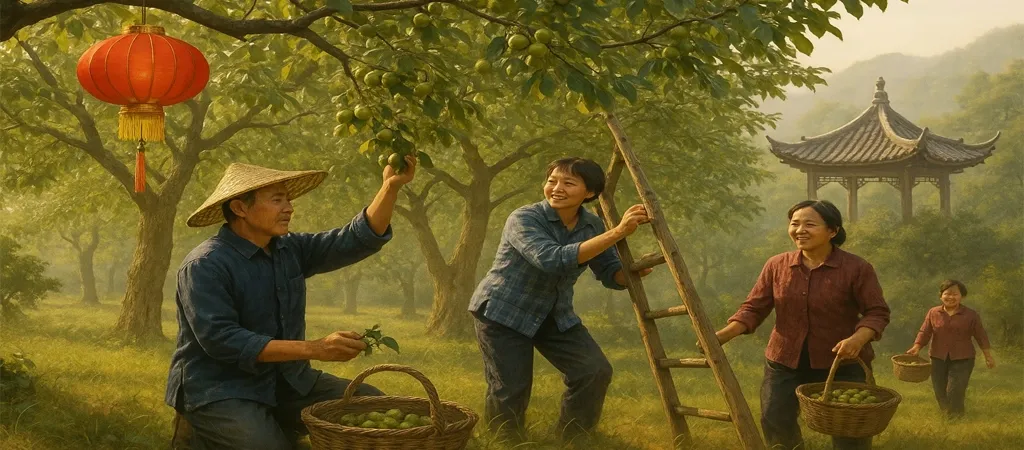As spring draws to a close and early summer begins in the Northern Hemisphere, walnut harvests are already underway in China, particularly in major regions such as Xinjiang and Yunnan.
It is a critical period for all stakeholders, including farmers, marketers, and buyers globally, because China is today the world's leading walnut producer. They processed a record 1.55 million tonnes of walnuts during the latest harvest period, which is 14.8% up from 2023.
Key Takeaways:
* Harvest widespread in Xinjiang & Yunnan, but environmental threats loom.
* Quality-enhancing tech adoption is notable.
World markets are seeking China due to declines in U.S./Chilean supplies.
Actively managing contracts and carefully monitoring quality will be critical.
Places and Production Forecast
A. Xinjiang Region
Xinjiang is a major walnut-growing area for China. 42,470 hectares are being planted, and some are already being harvested, such as Aral City, where 5,300 hectares are being harvested now.
Producers utilize new technology, such as X-ray sorting, to raise kernel purity to nearly 99.9%. This is particularly appealing for uses that demand many kernels.
B. Yunnan Province
Yunnan received a good, steady supply for the year.
* Nevertheless, low yields of fruits and the quality of the harvest heavily depend on weather and quality inspections.

Environmental Issues & Threatened Plants
Bad weather impacted China's new walnut crop. Sandstorms from the north, particularly from the Xinjiang Xingfu type, impacted pollen quality, raising concern about potentially lower harvests. More disturbing, spring frosts late in the growing cycle inflicted a great deal of harm to walnut orchards, killing fragile flower buds and new nuts, which can lower the size of the crop and yields of nuts.
Consequently, even for favorable yields, these weather occurrences now jeopardize the supply of new crops. This concerned processors and suppliers, which caused them to recommended that users place early orders because prices are likely to remain high or even increase based on growing uncertainty.
Considering Harvest Expectations
* Crop 2024: Approximately 1.55 million MT in-shell was produced; that is 14.8% more than in 2023
* Projected 2025/26 output: Early optimism, with kernel quality better than previous years, assuming favorable harvest weather.
But cold weather and sandstorms can exacerbate the condition of kernels more than “bumper harvest” prospects.
Viewing Inventory and Processors
They don't possess many complete nuts, and are a bit concerned that new harvests will not wholly fill this gap.
They instruct purchasers to purchase now because some ambiguity regarding supply for this year might occur.
Good quality control is critical, particularly for kernel size, shell colour, and processing requirements, to reach EU and Middle Eastern export market standards.

Market Actions and Price Changes
Walnut-in-shell prices are holding steady or increasing because everyone is looking for them. Walnut kernel prices, particularly the superior ones, are not that high because merchants are clearing their remaining inventory of the year. Still, despite this decline, superior kernel grades such as ELH 90% are desired because they are of exceptional quality, highly demanded, and are desired even more than before.
Utilising apps from import sites
European, Middle Eastern, and Indonesian markets are searching for contracts, particularly for in-shell nuts.
Significant locations:
* Europe – desires consistent kernel quality
* Middle East & North Africa – growing demand for substantial quantities of products
* Turkey – demand is high, Chinese walnuts are increasing competition
What's Going On These Days: China, USA, and Chile
* China remains the top global walnut producer with \~1.55 M MT in-shell.
* U.S. production fell (\~27% drop), tightening domestic supply.
Chile was better (+20% projected), but still not bigger than China's scale.
Those exported from China are less expensive than American and Chilean walnuts.
Changes in Trade and Export
China ramps up exporting whole and shelled walnuts to the Middle East, North Africa, Asia, and Europe.
It sells more kernels to these regions due to superior prices and superior quality management.
Future: Risks and Opportunities
Warnings:
* Crops are being lost due to weather occurrences (frosts, sandstorms
* Small quantities of processing material
* Variation of quality in various regions
Positives:
* Enhanced kernel information with more transparent processing
Good initial deals for foreign buyers purchasing houses.
Since China is a big country, it can regulate prices globally.
* Opportunity for further betterment (health, simpler supply to verify)

Key Concepts for Stakeholders
Producers must invest more money in new sorting technology, such as X-ray selection, and meet quality standards for exporting.
Merchants and intermediaries must demand early harvest arrangements, particularly from Yunnan and Xinjiang producers. They have to conclude deals on acres soon because shares are limited and market prices are steady. They can assist policymakers by making technology more available and addressing methods of lowering supply chain risk.
Summary
China's 2025 walnut harvest holds promise for high production, robust global market demand, and improved quality, but is prepared for weather-related uncertainties and pressure from limited supply. Its leadership of production globally underpins stable market pricing and foreign competitiveness, despite kernel market pressure downwards resulting from aging-in carry-ins and nervous processor demeanor.









